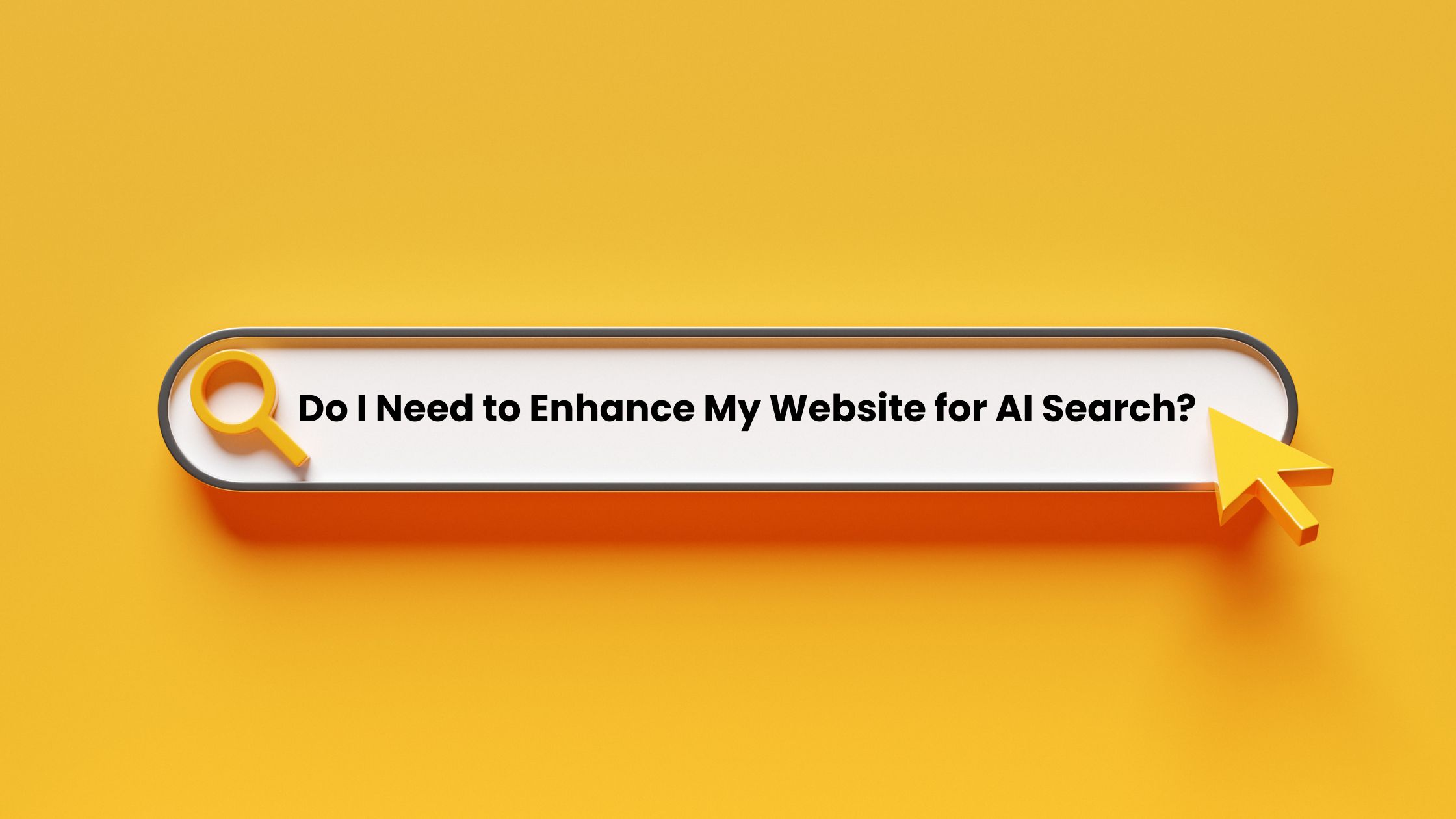Search has changed — and most websites haven’t caught up.
If your website is built around keywords and rankings alone, it’s already behind.
The next generation of search — powered by AI systems like Google AI Overviews, ChatGPT, and Siri — no longer lists pages the old way. Instead, it summarizes the web, choosing a handful of sources to quote or reference directly in its answers.
That means visibility is no longer about where you rank. It’s about whether you’re cited.
This is where AI SEO comes in — a new way of optimizing content so that search engines and AI systems can interpret, trust, and summarize your information correctly.
Quick Answer
Most websites aren’t ready for AI search. AI systems like Google’s AI Overviews and ChatGPT select only a few structured, trusted pages to display inside their answers. Enhancing your site for AI search means using schema markup, clear entities, and question-based content so your information can be understood, summarized, and cited by AI engines.
What Is AI SEO (and Why It Matters Now)
AI SEO, short for Artificial Intelligence Search Engine Optimization, focuses on helping AI systems understand and feature your content inside their generated answers.
You’ve likely seen this shift already:
- Google AI Overviews now appear above search results, summarizing topics and citing a few trusted sites.
- ChatGPT and Gemini generate direct responses when users ask questions — often referencing live web sources.
- Voice assistants like Alexa or Siri respond conversationally, drawing from structured data.
This is part of a wider transformation in how people search. Users no longer want to scroll or compare dozens of links; they want an instant, summarized answer. AI systems now determine which sources get quoted — and which get ignored.
That’s why AI SEO (or Generative SEO, GEO) is so important. It’s about optimizing not just for algorithms but for understanding.
Most websites aren’t AI-ready because AI systems rely on structured data, entities, and clear answers. Enhancing your site for AI search means making your content factual, structured, and machine-readable.
Why Traditional SEO Isn’t Enough Anymore
Traditional SEO was built for a predictable ecosystem — search engines crawled, indexed, and ranked web pages based on backlinks, keywords, and metadata.
That system still exists, but AI has layered a new interpretation model on top.
Instead of showing 10 links, Google’s AI Overview might summarize a topic using only three to five carefully chosen sources.
Here’s what’s changed:
- Search behavior is now conversational — people ask natural questions like, “What’s the best home care agency near me?”
- Search surfaces have expanded — Google’s AI Overviews, Bing Copilot, Perplexity, ChatGPT, and voice assistants all pull from web data differently.
- Engagement metrics are shifting — more users find what they need without clicking, making zero-click visibility a crucial goal.
If your website isn’t structured for AI understanding, it’s invisible to this layer of search — even if it ranks on page one.
| Traditional SEO | AI SEO (Generative SEO) |
| Focuses on rankings | Focuses on citations |
| Keywords drive visibility | Entities and schema drive visibility |
| Goal: clicks & traffic | Goal: mentions & credibility |
| Optimized for algorithms | Optimized for AI summarization |
| Measures: position & CTR | Measures: citations & impressions in AI |
Both are essential — but traditional SEO helps you get found, while AI SEO helps you get featured.
Signs Your Website Isn’t AI-Ready
Many business owners assume a high-ranking website automatically performs well in AI search. In most cases, it doesn’t.
AI visibility requires additional structure and context that older SEO frameworks often lack.
Here are common signs that your site isn’t ready for AI search:
- No structured data or schema markup.
Without FAQ, HowTo, or Product schema, your site can’t communicate its meaning to AI systems. Schema acts as a label that tells machines what each element represents. - Thin or keyword-heavy content.
AI models prefer pages that demonstrate authority — factual, organized, and educational. Over-optimized text or vague statements tend to be skipped. - Lack of entity clarity.
Entities are people, places, products, and concepts your brand connects to. If your content doesn’t make those connections explicit, AI struggles to identify relevance. - Missing or incomplete author and business info.
Expertise and transparency matter. Pages without identifiable authors or clear “About” sections are less trusted by generative systems. - No Q&A or conversational structure.
AI engines learn context through questions and answers. Content that mirrors how people search (“How do I…?” “What’s the best way to…?”) performs better. - Inconsistent brand or local signals.
If your site mentions locations or services differently across pages, AI might not connect them to your business consistently.
These are structural issues, not just ranking issues. They determine whether AI can understand and cite your content.
How AI Systems Choose What to Show
When AI engines generate summaries, they look for three key things:
- Authority:
Does this website demonstrate experience, expertise, and credibility (E-E-A-T)?
Citations, detailed author bios, and external references help. - Structure:
Is the content formatted for quick parsing — using headings, lists, schema, and short factual sections?
Machine-readable formatting is crucial. - Relevance:
Does the page directly answer the user’s query in a clear, concise way?
Long introductions or keyword stuffing make comprehension harder for AI.
In short, AI doesn’t just read your content — it interprets your intent.
Sites that anticipate user questions and organize around them are far more likely to appear in AI results.
What “AI Optimization” Really Involves
AI optimization combines traditional SEO with structures that help search engines and AI models understand meaning — not just match keywords.
- Structural Optimization
Make your website readable for both humans and AI.
- Add FAQPage, HowTo, and LocalBusiness schema.
- Use clear headings, semantic tags, and fast, mobile-friendly design.
- Eliminate clutter and repetition for easier machine parsing.
Goal: Create pages that AI can interpret as clearly as a database.
- Content Optimization
AI extracts meaning, not just text.
- Lead with Answer Cards — short, factual summaries.
- Use bullet lists, brief paragraphs, and tables.
- Add FAQs to mirror conversational searches and boost zero-click visibility.
Goal: Structure content the way people ask — and AI answers.
- Entity & Trust Optimization
AI only cites what it trusts.
- Add verified author bios and team expertise.
- Use internal links for topical authority and outbound links to credible sources.
- Keep brand and location details consistent everywhere.
Goal: Build trust signals that make your site a credible source for AI citations.
How to Make Your Website AI-Friendly (Quick Wins)
Improving AI visibility doesn’t require a full rebuild. Start small, but with structure.
Here’s a simple step-by-step plan:
- Audit your content for schema and question-based formatting.
- Add 3–5 FAQs to your top-performing service or product pages.
- Introduce short summaries at the start of each page or section.
- Update your “About” page with credentials, experience, and author bios.
- Interlink your content by topic instead of keywords.
Over time, these small changes create the framework AI systems use to connect your site to real-world topics and entities.
The ROI of Being AI-Ready
While AI SEO is still an emerging field, measurable results are already appearing.
Websites optimized for AI visibility tend to show improvements across three major areas:
- Higher brand mentions in AI summaries.
Being cited by Google’s AI Overview or ChatGPT not only drives awareness but also reinforces credibility when users see your brand quoted in authoritative answers. - Improved zero-click visibility.
Even when users don’t click, they often remember cited brands. This builds recognition and drives later direct or branded searches. - Increased voice search exposure.
Optimizing for conversational content (“Who offers…?”, “How much does…?”) helps businesses appear more often in voice assistant responses.
The benefit isn’t just immediate traffic — it’s long-term visibility and brand trust in how AI systems learn and present information.
What This Means for Businesses
Adapting for AI SEO isn’t about chasing another algorithm; it’s about staying visible in the way people now search.
As AI systems become the default interface for discovery — from Google to ChatGPT to Siri — the businesses that prepare now will retain visibility long after keyword-driven SEO alone stops delivering results.
Being AI-ready means:
- Structuring your content for context and comprehension.
- Providing verifiable expertise and trust signals.
- Speaking the same language as search — conversational, factual, and clear.
The shift is already happening quietly in the background. Most users just don’t realize it yet.
Final Thoughts
Search is evolving into a system of understanding, not just indexing.
For businesses, that means visibility depends less on where you rank and more on how well AI systems can interpret your information.
Becoming AI-ready isn’t a one-time project — it’s an ongoing process of clarity, structure, and trust.
Websites that invest in these foundations today will be the ones AI cites tomorrow.
Key Takeaways
- AI SEO = Visibility beyond rankings. It focuses on being cited in AI-generated summaries, not just listed in search results.
- Structure matters. Schema, entities, and FAQ-based formatting help AI systems interpret and quote your content.
- Voice and conversational search are growing. People now search with questions like “Who offers this near me?” — your content should match that tone.
- Traditional SEO still counts. Ranking builds authority; AI SEO builds credibility. The two work best together.
- Being AI-ready builds future-proof visibility. Brands that prepare now will dominate zero-click, voice, and generative search results.

